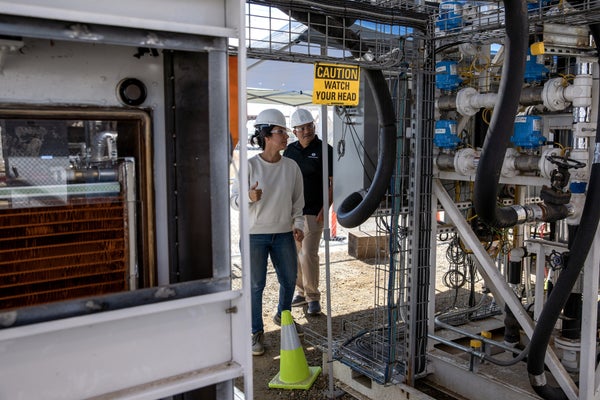The U.S. Will Need to Spend $100 Billon a Year on Carbon Removal
The U.S. needs to vastly increase taxpayer spending on direct carbon removal technology to meet President Biden’s climate goals, the Rhodium Group says

Avnos Inc. engineers at a hybrid direct air carbon capture technology pilot site in Bakersfield, California, US, on Wednesday, Oct. 25, 2023.
Alisha Jucevic/Bloomberg via Getty Images
CLIMATEWIRE | The U.S. government needs to spend roughly $100 billion annually on carbon dioxide removal by 2050 to help the world avoid extreme climate change, according to an analysis released Wednesday.
That’s 20 times more than what lawmakers committed to in landmark climate bills that aimed to jump-start the development of carbon removal technologies and companies, the Rhodium Group estimated. For context, the sum is also about as much as the entire budget of the Department of Agriculture.
The new analysis comes amid a fierce battle for control of Congress, the White House and the future of U.S. climate policy. The Republican Party is rallying behind former President Donald Trump, whose campaign has promised that if reelected he would “oppose all of the radical left’s Green New Deal policies.”
On supporting science journalism
If you’re enjoying this article, consider supporting our award-winning journalism by subscribing. By purchasing a subscription you are helping to ensure the future of impactful stories about the discoveries and ideas shaping our world today.
But Rhodium’s calculations could also bolster progressive critics of carbon dioxide removal who view government subsidies for the costly technology as a distraction in the fight against rising temperatures. Carbon removal companies use a variety of natural and engineered approaches to boost the carbon absorbing capacity of the planet.
The industry’s need for so much additional taxpayer money is a function of both science and economics, the report explained.
Even in scenarios where heat-trapping carbon dioxide emissions fall rapidly and carbon-absorbing ecosystems like the Amazon rainforest are protected, climate scientists estimate that the world will need to remove billions of tons of CO2 from the air and oceans in coming decades to avoid global warming of more than 2 degrees Celsius above pre-industrial levels. That’s a warming goal established in the Paris Agreement based on scientific estimates that dangerous effects of climate change could accelerate dramatically if that threshold is passed.
But carbon dioxide removal, or CDR, can’t reach the scale necessary to remove a billion tons of CO2 per year because interest in the industry’s services is currently limited to a collection of large corporations whose support may wane.
“Growth in CDR support from the voluntary markets is dependent on the extent to which companies keep net-zero commitments and how many more companies commit to them, how successful companies are in decarbonizing with other levers, and how permissive standard setters are in allowing CDR,” the report said. “Because of this level of uncertainty, if the US wants to be on track to have access to at least a [billion tons] of annual CDR by mid-century, they should prepare to supply the necessary revenue support under federal policy.”
Rhodium suggested that Congress could implement a permanent federal carbon removal procurement program to achieve the level of funding needed to meet the Biden administration’s climate commitments.
The report acknowledged that it’s currently “difficult to envision a scenario where there is sufficient political will to enact legislation for a procurement program with at least $100 billion per year in funding,” but suggested that “putting in place a less ambitious program sooner may be an important stepping stone towards what’s ultimately needed.”
Other options for boosting federal spending include expanding and extending carbon removal tax credits, which the report noted could avoid a Senate filibuster “as part of a budget reconciliation process.”
The report, which was funded by some foundations that support carbon removal, acknowledged many common critiques of the fledgling industry. A massive expansion of biomass-based approaches, for instance, could in theory threaten existing forests or croplands. And it noted that major direct air capture facilities, the most heavily subsidized carbon removal technology, “could require between 180-500 MW of electric generating capacity — the size of a large wind farm or solar array.”
Those are significant concerns for carbon removal skeptics such as Joseph Romm, who led the Energy Department’s renewable energy office during the Clinton administration. In an essay planned for the forthcoming edition of the nonprofit Environmental Law Institute’s journal, he argued that there are substantial opportunity costs of investing in carbon removal facilities.
“The bottom line is that right now, for every ton of CO2 removed by a [direct air capture carbon capture and storage] system, we effectively raise ambient CO2 levels by 10 to 20 tons since that’s how much emissions we could have reduced if we had not misallocated the renewable energy along with all of the money and effort needed for DACCS,” wrote Romm, who is now a senior research fellow at the University of Pennsylvania’s Center for Science, Sustainability and the Media.
But Rhodium estimated that some carbon removal approaches will see their energy efficiency increase and the price they charge per ton of CO2 removed decrease over time. The goal, the report said, should be “to incentivize a set of CDR solutions that maximizes avoided climate damages while minimizing costs to US taxpayers.”
Reprinted from E&E News with permission from POLITICO, LLC. Copyright 2024. E&E News provides essential news for energy and environment professionals.

